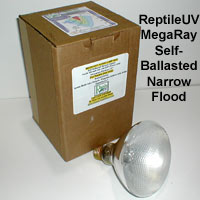 Lamps
on Test.
Lamps
on Test. The ReptileUV Mega-Ray Series of Mercury Vapour Lamps
Report by Frances Baines for www.uvguide.co.uk
Introduction - lamps on test - testing methods - results: direct readings (UVB - UV Index - UVC - lux - long-term decay ) - spread charts spectrograms - power consumption - summary - references
UVB in nature and in the vivarium
Sunlight in tropical and sub-tropical regions has UVB levels typically
rising to 300-400 uW/cm² (with a UV Index of about 7 - 10) by mid-day. On a
clear day, levels may rise to above 100 uW/cm² (UV Index 1.5 - 2) within two
hours of sunrise. Even in the shade or under overcast skies, 100 uW/cm² or more
may be recorded throughout the middle of the day. (1, 2)
In view of the benefits of both UVA and UVB, most authors now recommend that diurnal lizards, at least, be provided with appropriate UV light, either from natural unfiltered sunlight (in climates where this is possible) or from artificial sources, more of which become available to the hobbyist every year. (3,4,5,6)
Until relatively recently, few artificial sources provided anything but very low intensity UVB at short range.(7) Specialist fluorescent tubes marketed for reptiles, described as 5% or 8% UVB, for example, when new typically emit only 15 – 25 uW/cm² at 12 inches.(8) Whereas this may be ideal for reptiles with low UVB requirements (such as some species of chameleons) or for reptiles in small enclosures, the use of these tubes to provide UVB to sun-loving lizards in larger enclosures is somewhat impractical.
Over the last few years, high-UVB output mercury vapour lamps designed for reptiles have become available to the hobbyist. The spectrum produced by a mercury vapour lamp, with emissions at discrete wavelengths, is very unlike the continuous spectrum of the sun. However, studies to date do not suggest that this adversely affects the production of vitamin D3 in the skin. Rather the reverse; there is growing anecdotal evidence (9), and at least two published studies (10, 11), suggesting that such lamps do promote D3 synthesis and, when set up in suitably sized enclosures, may be beneficial to diurnal lizards which normally bask in full sunlight in the wild. To provide a more normal visible spectrum and additional heat, where this is required, regular halogen, tungsten or metal halide basking lights may be used in conjunction with these mercury vapour lamps.
UVB and vitamin D3
It is not sufficient merely to supply "high" levels of UVB to a reptile.
The wavelengths of UVB produced by the lamp must be in the correct range for
vitamin D3 production to occur. Vitamin D3 is synthesised in the skin from the
cholesterol precursor 7-DHC in a two-stage process. The first stage, its conversion
to pre-vitamin D3 (pre-D3), occurs only in the presence of low-wavelength UVB
(below about 315nm.) Pre-D3 is then isomerised to vitamin D3 in a temperature-dependent
process (12).
In nature, the proportion of solar UVB which is in these lower wavelengths varies
depending upon the altitude of the sun. The higher it is in the sky, the less
these low wavelengths are absorbed by the atmosphere. When assessing the potential
of UVB-producing lamps in the vivarium, it is therefore necessary to examine
both the overall output of the lamp and the range of wavelengths which are being
emitted.
The mercury vapour lamps made by Westron of Canada are claimed to emit UVB at levels approximating those found in sunlight (150 – 250 uW/cm²) at suitable basking distances in the vivarium. These lamps were designed for this purpose by iguana rehabilitator Robert MacCargar, who has experience with ultraviolet ‘curing lamps’ for the automotive industry (which are very resistant to decay). MacCargar distributes a range of lamps with this design through his own company, sold under the brand name ReptileUV Mega-Ray; the lamps are also sold under the brand name Active UV Heat Flood by T-Rex Products, Inc. and Get Wild Inside (Metamorph Enterprises). Details of the precise wavelengths of UVB produced by these lamps have not been previously published. This report describes the ReptileUV Mega-Ray series of Westron lamps in terms of their output at all wavelengths, decay in UVB output during use, and beam characteristics.
Although there is not, as yet, a UK distributor for the ReptileUV Mega-Ray lamps, these are available by mail order from USA from the company website, www.ReptileUV.com.
Self-ballasted (SB) lamps (100watt and 160watt) (Figure 1) are sold in both 110volt and “Euro” 220volt versions. An externally ballasted (EB) 60watt lamp is available with a matching ballast box (110volt only)(Figure 2). There is also a Mega-Ray Zoo Lamp for specialist use, such as in zoos, in situations where high UVB levels are required at distances over 3 feet from the lamp, in very large enclosures.
ReptileUV state that (with the exception of the Zoo Lamp) output of individual lamps may vary somewhat within each range. When ordering, it is possible to request a specific output for a specific set-up, since the output of each lamp is checked before dispatch. We requested a full range of lamps, although we were told that if no particular request is made, a lamp with a "standard" output of 150 – 250 uW/cm² is supplied.
For detailed testing, nine lamps were kindly donated by Robert MacCargar of ReptileUV between 2004 and 2006. UVB readings were also taken from two other ReptileUV EB Mega-Ray lamps, in situ in vivaria.
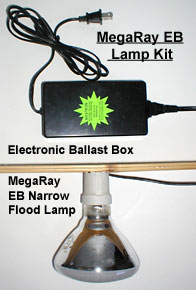 Four
lamps (Reference nos. BM1, 2, 3 and 6) were "high output" lamps
specifically requested for a large bearded dragon vivarium, with the basking
shelf 18" below the lamp. Two of these were SB 100watt, 220volt lamps;
two were EB 60watt, 110volt lamps.
Four
lamps (Reference nos. BM1, 2, 3 and 6) were "high output" lamps
specifically requested for a large bearded dragon vivarium, with the basking
shelf 18" below the lamp. Two of these were SB 100watt, 220volt lamps;
two were EB 60watt, 110volt lamps.
One lamp (Ref. no. BM9) was a so-called "Mega-Ray Low" from the SB Mega-Ray range - a 100watt, 220volt lamp, supplied for a chameleon set-up where a lower level of UVB is normally required.
One lamp (Ref. no. BMZ1) was a Mega-Ray Zoo Lamp; this was an EB, 60watt, 110volt version.
The remaining five lamps (Ref. nos. BM 4, 5 and 10 and HM1 and 2) were all "standard output" EB, 60watt, 110volt lamps supplied for medium-sized vivaria, with a recommended minimum basking distance of 12" beneath the lamp.
All except for the Zoo Lamp were received with their output at 12" hand-written on the box. This ranged from 70 uW/cm² (the “Mega-Ray Low”) to 488 uW/cm² (Lamp ref. BM1, described as a prototype SB lamp for a large bearded dragon enclosure).
The lamps on test were set up in a ceramic holder affixed to a batten close to the ceiling of the test room, allowing measurement up to 72" from the face of the lamp. Many UVB-emitting lamps demonstrate a rapid period of decay in UVB output (often described as “burning-in”) over the first few days of use, followed by a slower decline in output over subsequent months. To establish whether this occurs in the lamp under test, and to ensure each lamp is tested in a comparable manner, a burn-in time of at least 80 – 100 hours was allowed for in all our testing regimes. Most lamps take several minutes to reach full brightness. Tests were only performed on lamps which had been alight for at least 1 hour directly before testing (or 30 mins for the first test).
After the initial testing programme was completed, one SB lamp and one EB lamp were installed in suitable vivaria and long-term testing was carried out, with recordings made every 1,000 hours (representing approximately 3 months' use at 10 - 12 hours per day, depending on season).
Four types of recordings were made, using a range of broadband meters and a UV-VIS spectrometer as these became available during the course of the project.
Equipment.
The UVB meter used for all tests is a hand held ultraviolet radiometer, the Solarmeter Model 6.2 UVB manufactured by Solartech Inc. (www.solarmeter.com) Although it measures the complete UVB range (280 nanometers to 320 nanometers) the Solarmeter's peak sensitivity is in the lower part of the range, at around 286nm, which makes it useful for checking UVB reptile lamps.
The UVI meters are similar hand held ultraviolet radiometers, the Solarmeter Models 6.4 and 6.5 manufactured by Solartech Inc. These are designed to indicate the intensity of UVB radiation at the wavelengths that enable skin synthesis of vitamin D3 in the skin. The sensor’s response follows the Diffey Erythemal Action Spectrum effective irradiance (Eeff), which closely follows the vitamin D action spectrum (Deff) in the short-wave ultraviolet (280 – 320nm). We are currently evaluating the use of these meters in reptile husbandry, by taking readings from all reptile lamps, as well as solar readings.
The UVC meter is the Solarmeter Model 8.0 UVC manufactured by Solartech Inc. This meter is only sensitive to ultraviolet emissions between 240 - 280nm. (UVC radiation)
The lux meter is a simple hand-held device, a Skytronic LX101 model 600.620 digital lux meter which measures the intensity of visible light, with maximum sensitivity around 560nm.
The spectrometer we use is an Ocean Optics Inc. USB2000 spectral radiometer with a UV-B compatible fibre-optic sensor with cosine adaptor, calibrated for absolute intensity. (www.oceanoptics.com)
The power consumption of each lamp is recorded using a Prodigit Power Monitor model 2000M-UK (www.prodigit.com.)
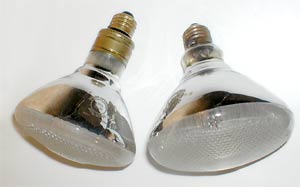 The
EB Mega-Ray lamp is a PAR-38 reflector lamp with a moulded spreader lens on
the surface and a slightly milky inner coating. Earlier models (2004-5) had
short glass necks; newer lamps have a longer neck with a brass collar (Fig.
3.)
The
EB Mega-Ray lamp is a PAR-38 reflector lamp with a moulded spreader lens on
the surface and a slightly milky inner coating. Earlier models (2004-5) had
short glass necks; newer lamps have a longer neck with a brass collar (Fig.
3.)
The EB lamp and ballast box are purchased as a kit; replacement lamps may then be purchased separately. At present these kits are only available in an 110volt version (the USA line voltage) and to operate them in the UK, with our 220-240volt mains electricity, we used a step-down transformer.
We found that some of the ceramic lamp fixtures we tried would not accommodate the bulbs with the brass collars, because the lamp would not screw far enough into the fitment. Bending the contacts within the fixture down towards the lamp solved this problem in most cases.
As with all externally ballasted mercury vapour lamps, when first switched on, the lamp produced a faint light from the arc tube which developed over a few minutes into a very bright light with (to the human eye) a purplish-blue tint and a directional beam.
The SB Mega-Ray lamp is almost identical in appearance except for the tungsten filament, which can be seen inside the lamp. A self-ballasted lamp, when first switched on it emitted a very bright yellow-white light from the tungsten filament which changed in tone to a bluer tint as the arc tube lit up and the beam developed.
The Mega-Ray Zoo EB Lamp is identical in appearance to the EB Mega-Ray lamp except that there is no milky coating on the inner surface of the lens; the glass appears completely clear.
Because of the physical movement of the arc within the tube, and the way the radiation is generated, the meter readings from mercury vapour arc tubes are rarely steady at close range, and in fact the visible light can often be seen to "dance" as well, casting flickering shadows at the edge of the beam. For consistency, the highest reading seen three times at each distance is the one recorded, as it is assumed that this reading represents the most accurate alignment of the hand-held meter with the beam.
New lamps were “burned-in” for at least 90 hours before these recordings were made. All readings were taken after the lamps had been switched on for at least 30 - 60 mins, to ensure they were fully warmed up and the output stable.
A series of direct readings were taken with the Solarmeter 6.2 UVB meter at increasing distances from directly beneath the centre of the lamp face. Figure 4 shows the output of all ten Mega-Ray lamps which were included in the trial.
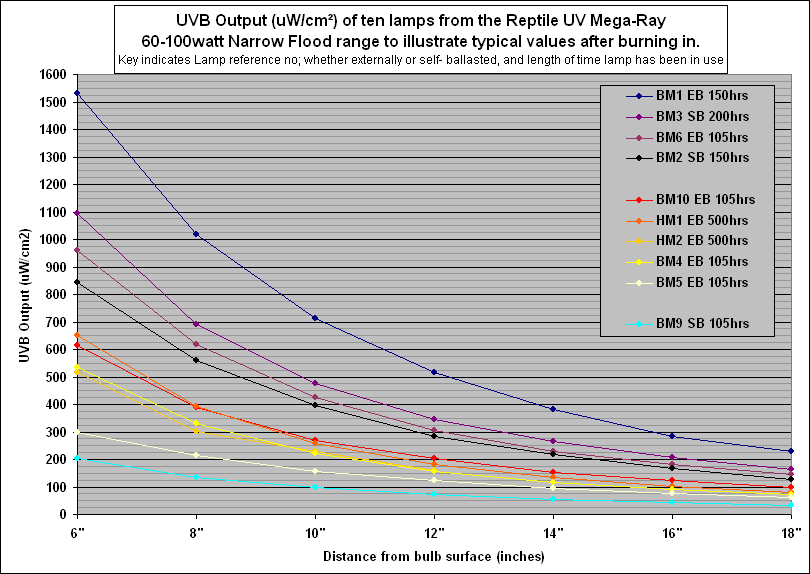
The results show that these lamps do indeed emit UVB at the levels specified. There was wide variation between individual lamps; this has proven to be a feature of every brand of mercury vapour lamp we have tested so far. In this case, this was expected, since the lamps were labelled with their output as recorded prior to dispatch.
Readings at close range were higher than seen in nature, but at 18" (manufacturer’s recommended minimum distance) the four specially-requested "high-output" lamps produced levels of UVB resembling that found in natural sunlight – they emitted between 127 and 228 uW/cm² after burning-in.
At 12" (manufacturer’s recommended minimum distance) the four "standard-output" lamps produced similar levels, between 122 and 202 uW/cm². The "Mega-Ray Low" was emitting 71 uW/cm².
Figure 5 shows the output of the EB Mega-Ray Zoo Lamp after burning-in.
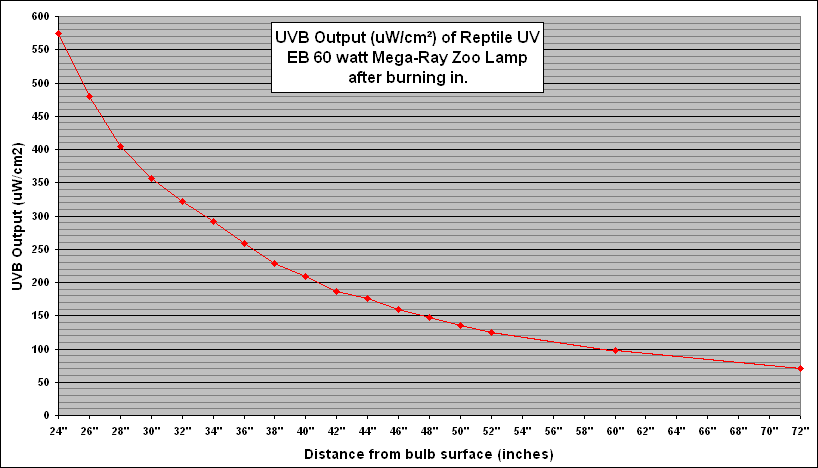
This lamp, designed for use only in very large enclosures, has a vastly higher UVB output. The recommended minimum basking distance is 36 inches; at this distance the output was 259 uW/cm². At 72" the lamp was still emitting 70 uW/cm². At all distances closer than 26", readings were higher than seen in nature even in the tropics.
In many countries, especially in the summer, the Solar UV Index is reported along with the weather forecast in newspapers, on TV and on the radio. The colour-coded Index is easily understood and is becoming widely recognised. To quote the World Health Organisation (from their online booklet, Global UVI ):-
The Global Solar UV Index (UVI) is a simple measure of the UV radiation level at the Earth’s surface and an indicator of the potential for skin damage. It serves as an important vehicle to raise public awareness and to alert people about the need to adopt protective measures when exposed to UV radiation.
More details of the Solar UVI throughout the world may be found at the website of the World Meteorological Organization (WMO) with links to UVI Index reports from many countries from http://www.srrb.noaa.gov/UV/lindex.html .
The UV Index is derived from a formula that follows the way that different wavelengths of UV light affect human skin causing erythema (sunburn) - the action spectrum for UV-induced erythema. There are 2 ways of obtaining it; the first is to use a spectroradiometer and to calculate the UVI using the formula. The second is to use a broadband meter that has been calibrated and programmed to give the UVI directly. Two models of Solarmeter - the Solarmeter 6.4 and the Solarmeter 6.5 - are available with just such a calibration. The 6.5 gives the UVI directly. The 6.4 gives a reading of International Units of D3 per minute for human skin of a certain type - but this is easily converted to the UVI by a simple mathematical calculation as indicated by the manufacturer.
The action spectrum for human erythema is very similar indeed to the action spectrum for the production of preD3 in human skin (and reptile skin). In fact, the response curve of the sensor/detector used in these two meters, as shown on the manufacturer's website, appears to follow the so-called D3 action spectrum even more closely than it does the erythema action spectrum. Hence, the UVI may be used as an indication of the ability of the light source to produce vitamin D3 in our reptiles as well as its ability to give humans a sun-burn. In addition, because of this response curve, these meters - in theory at least - should be less affected by differing spectral power distributions at higher UVB wavelengths, above those facilitating D3 synthesis. As a result, they should therefore predict the ability of the lamp to stimulate vitamin D3 production more accurately than the Solarmeter 6.2.
The output of six of the Mega-Ray lamps was recorded with the Solarmeter 6.4. The results, expressed in UVI units, are shown below in Figure 6.
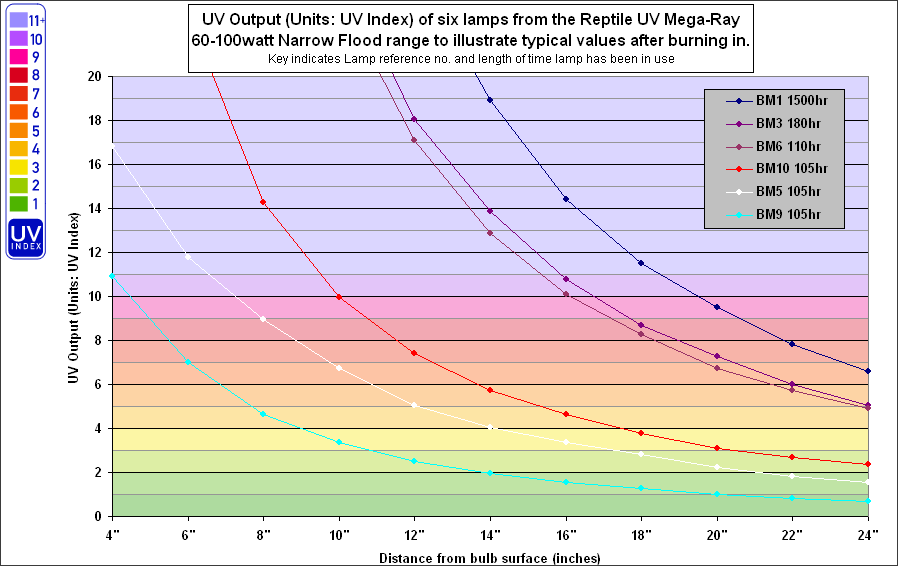
At the recommended minimum basking distance of 18", the three "high-output" Mega-Ray lamps (BM1, 3 and 6) give readings between UVI 8.3 and 11.5. These readings are comparable to the high solar UVI seen around mid-day in summer sunlight from temperate (UVI 7 - 9) to tropical regions (UVI 9-10 or above). The two "standard" output Mega-Ray lamps (BM5 and 10) gave UVI readings between 5.0 and 7.4 at 12 inches - equivalent to moderate levels of solar UVI seen in spring, summer and autumn in temperate regions and during mid morning and mid afternoon in more tropical areas. The Mega-Ray "Low" (BM9) gave a UVI reading of 2.5 at 12 inches; equivalent to outdoor readings taken in the early morning or late evening sunlight, or in light shade during the middle of the day.
Figure 7 shows the output of the Mega-Ray Zoo Lamp as recorded with the Solarmeter 6.4, expressed in UVI units.
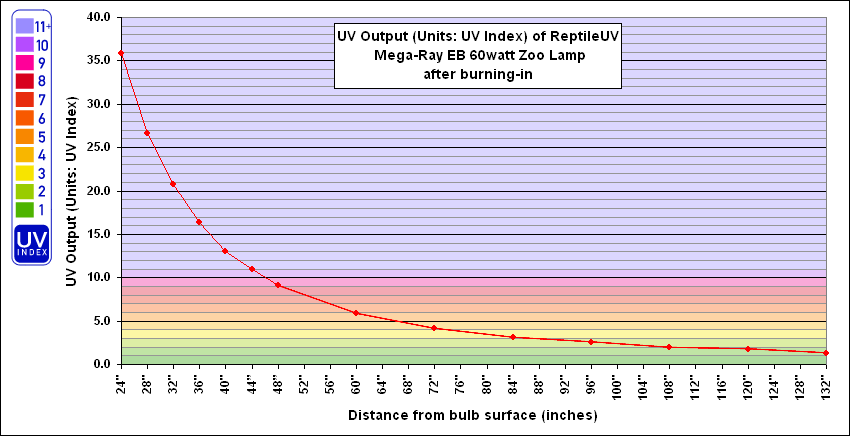
At the minimum recommended basking distance (36 inches) the UV Index is 16.4. This is a very high value rarely seen in the tropics, under very clear skies and at high altitudes. (The maximum solar UVI which can be recorded at the earth's surface is around 17.) From 40 to 60 inches away, the UVI is similar to solar levels found in summer sunshine in tropical and subtropical areas; but at a distance of 9 feet, the lamp still gives a UVI reading of 2.0 - similar to that found in the shade on a sunny day.
Figure 8 gives the results for recordings taken at close range from eight lamps tested with the UVC meter (Solarmeter 8.0).
| Fig. 8. | UVC Output (uW/cm²) | |||||
|
Distance
from lamp face
|
2" | 4" | 6" | 8" | 10" | 12" |
| BM1 EB Mega-Ray | 1 | 0 | 0 | 0 | 0 | 0 |
| BM2 SB Mega-Ray | 1 | 0 | 0 | 0 | 0 | 0 |
| BM3 SB Mega-Ray | 3 | 2 | 1 | 0 | 0 | 0 |
| BM5 EB Mega-Ray | 1 | 0 | 0 | 0 | 0 | 0 |
| BM6 EB Mega-Ray | 2 | 1 | 1 | 0 | 0 | 0 |
| BM9 SB Mega-Ray Low | 0 | 0 | 0 | 0 | 0 | 0 |
| BM10 EB Mega-Ray | 3 | 1 | 0 | 0 | 0 | 0 |
| BMZ1 EB Mega-Ray Zoo | 5 | 3 | 1 | 1 | 1 | 0 |
All the lamps except for the Mega-Ray Low emitted very small amounts of light in the wavelengths between 240 - 280nm at very close range. Although UVC is harmful to living cells and ideally, no lamp should emit UVC, most lamps which utilise mercury vapour do emit traces at close range. All fluorescent tubes we have tested, for example, give readings of between 1-3 uW/cm² of UVC at the tube surface; some occasionally register 1 uW/cm² of UVC at 1" distance. The closest we tested mercury vapour lamps (because of their high heat output) was 1-2"; all except for two brands produced between 1 and 36 uW/cm² at 2". However, at the distances at which the ReptileUV lamps are suitable for use in the vivarium, the UVC component is not of concern. With all these lamps it is undetectable with our meter (i.e. below 1 uW/cm²) at 12". UVC radiation only travels very short distances through air and it seems unlikely that any would reach a basking spot below one of these lamps.
The output from the Mega-Ray Zoo Lamp (ref. BMZ1) and six of the ReptileUV Mega-Ray lamps was recorded and the results are shown in Figure 9.
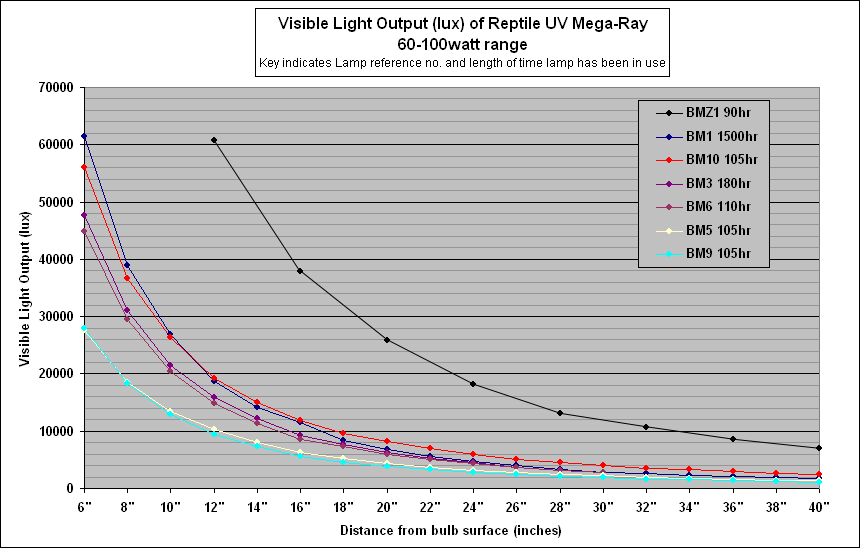
Typical published values for a brightly lit office, and for sunrise or sunset on a clear day, are around 400 - 500 lux. Those for a clear spring morning, just 30 minutes after sunrise in the UK, are around 10,000 lux. These are "global" readings with the lux meter aimed at the ceiling or zenith, not direct recordings from the light source or the sun. Our recordings complement these figures with, for example, a global reading of 6,000 lux and a direct solar reading of 31,600 lux at 5.00am GMT (close to sunrise) with clear skies on 21st June 2005.
Once the sun has risen in the sky, however, its brilliance cannot be matched by these mercury vapour lamps at distances which would be suitable for a basking lamp. For example, at 12.30pm GMT on 26th June 2005, also with clear skies, a global reading of 117,500 lux and a direct solar reading of 134,300 lux were taken. At the recommended minimum basking distances, the Mega-Ray lamps illuminate a basking spot with on average, about 10,000 lux. Although this is far superior to anything provided by most UVB fluorescent tubes we have tested (range: 350 - 630 lux at 12 inches) it is still, at best, only providing illumination, in terms of "visible light", similar to that of the sun just after dawn and before sunset.
(e) Long-term UVB recordings (long-term decay)
The manufacturers claim that on average, the Mega-Ray lamp will only decay 30 - 50% throughout its entire lifespan. They recommend annual replacement unless the owner has a UVB meter to monitor the decay. Their EB bulb is warranted for one full year to produce a minimum of 50 microwatts (uW/cm2) at 12”. This would make the product very different from most other UVB lamps and tubes we have tested. Some brands decay by more than 50% in their first 100 hours.
We charted the burn-in of six of the Mega-Ray lamps and the Mega-Ray Zoo Lamp. The burn-in chart for one of the EB lamps is shown in Figure 10. This lamp scarcely decayed at all during the first 105 hours burn, losing only 0.6% of its output at 12". The other five Mega-Ray lamps decayed between 1.6 and 5.7%; the Zoo Lamp decayed by 4.1%.
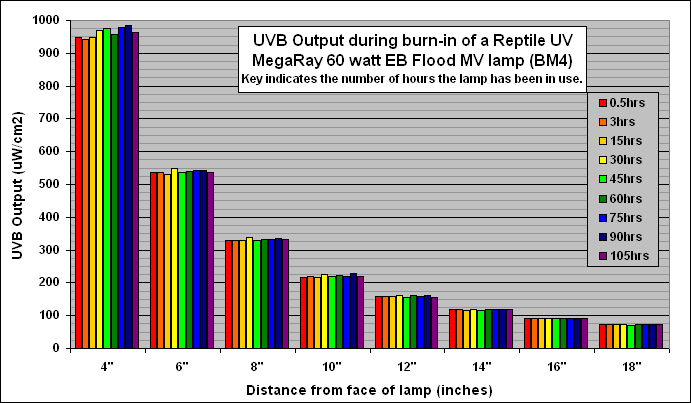
One of the SB lamps and two of the EB lamps were then tested regularly whilst in use in vivaria over a much longer period. The results for the SB lamp are shown in Figure 11. This lamp decayed by just under 5% in the first week, while it was burning-in. After this, it decayed by less than one percent a month, and over one full year it lost only about 15% of its original output. Initially, the lamp emitted 280 uW/cm² at 12". After 12 months this had only dropped to 240 uW/cm² at 12". After 18 months of use (10 - 12 hours a day, depending upon season) it is still emitting 233 uW/cm² at 12" and has lost only about 17% of its original output.
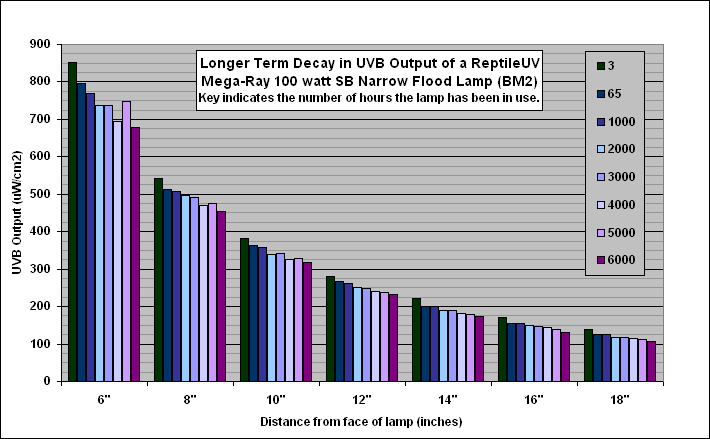
Figure 12 shows the long-term decay of one of the EB lamps over the same period. This lamp originally had the highest output of all the Mega-Ray lamps on test. In the first week, it only decayed about 6%. However, unlike the previous lamp its output fell by 36% in six months, 66% over its first full year and after 18 months of use it has decayed by 82%. The initial output at 12" was 546 uW/cm². After a full year this was 184 uW/cm² and after 18 months this has dropped to 98 uW/cm². This is still a high output, of course, but the decay does appear somewhat different to that of the other ReptileUV lamp in use for 18 months.
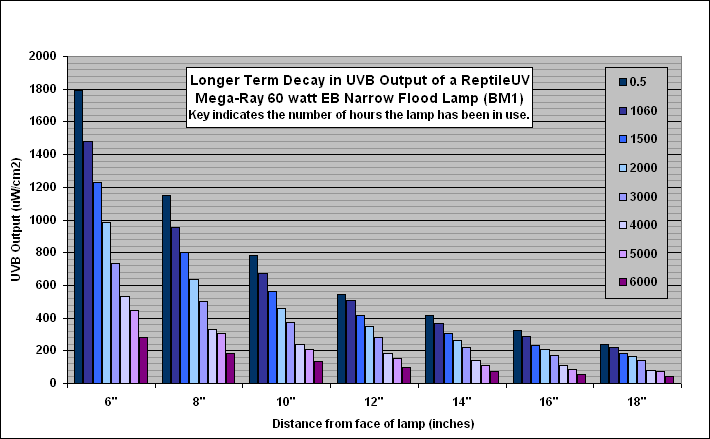
A second EB lamp has now been on long-term test for six months. This lamp decayed by 3.6% in its first week; it has now decayed by nearly 30%. The output is still high; initially it was emitting 310 uW/cm² at 12", and after 6 months' use, the figure is still 221 uW/cm².
This is too small a sample size to ascertain whether there is any difference between rates of decay in SB and EB lamps, or how representative these lamps are of their type. The first lamp tested for a full year only decayed 15%, but the second decayed 66%. In yet another respect, mercury vapour lamps appear to be a very variable product. Nevertheless, in comparison, we have tested other well-known brands of mercury vapour lamp which have decayed as much as 60 - 70% in their first 100 hours. Moreover, both lamps still had an output of over 100 uW/cm² at 12" after a year of use, which is much higher than any other lamp we have tested.
(a) UVB Spread Charts.
Whether a lamp is useful in the vivarium does not merely depend upon the intensity of its output as measured directly under the lamp. The shape of the beam, and hence the area of the vivarium which is illuminated with UVB light at the required intensity, is just as important. A detailed UVB spread chart recording the output of each lamp was made. This involves recording the output of the lamp in a two-dimensional plane directly beneath and to the sides of the lamp face. Direct readings are taken from several hundred points in this plane, and plotted on a chart so that a two-dimensional visualisation of the three-dimensional “cone” of radiation emitted by the lamp can be visualised.
The method used is fully described on the UV Guide UK website at www.uvguide.co.uk/makingspreadcharts.htm
Spread charts for both EB and SB Mega-Ray lamps were found to be very similar in shape. The overall extent of the beam is, as expected, proportional to the output of the lamp. The spread chart for one of the EB "standard output" lamps (output 202 uW/cm² at 12") is shown in Figure 13; the chart for the Mega-Ray "Low" (output 71 uW/cm² at 12") is shown in Figure 14.
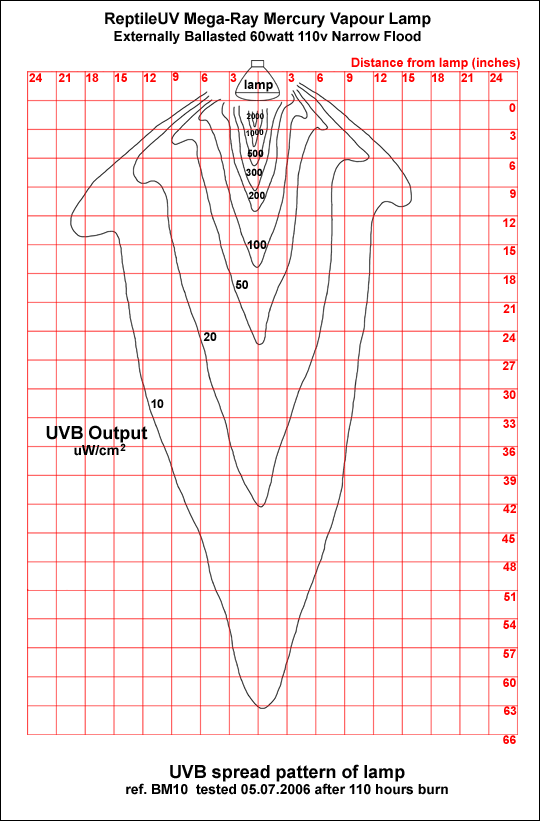 |
These lamps produce a very wide, cone-shaped beam of UVB radiation projected along the axis of the lamp, with an even gradient towards its centre. The intensity of the UVB also falls away evenly with distance, but the beam extends a long way. This beam certainly has characteristics of both “spot” and “flood” lamps and the term “Narrow Flood” seems very appropriate. The "standard output" lamp illustrated (ref. BM10) is producing a roughly circular footprint about 17" across at the minimum recommended basking distance of 12", within which is a gradient of UVB from 20 to 200 uW/cm². (The other two "standard output" lamps charted had even wider footprints - 22.5" and 30.5" respectively.) The "Mega-Ray Low" (ref. BM9) produces a beam of very similar shape but with a gentler gradient. At 12", the footprint is just over 14" across; within this is a gradient of UVB from 20 to 71 uW/cm².
|
The spread charts for the four "higher output" lamps (not illustrated) indicated that these too have a similar shaped beam but the footprint is correspondingly larger. At 18" (the minimum recommended basking distance for these lamps) the footprint with a gradient from 20 uW/cm² measured about 22" across (range: 16.8" to 28.6").
To visualise the effect of these high-UVB sources in the vivarium, the spread chart for each lamp can be superimposed on a photograph of a real set-up - if careful measurements are taken and the chart is scaled up correctly.
|
|
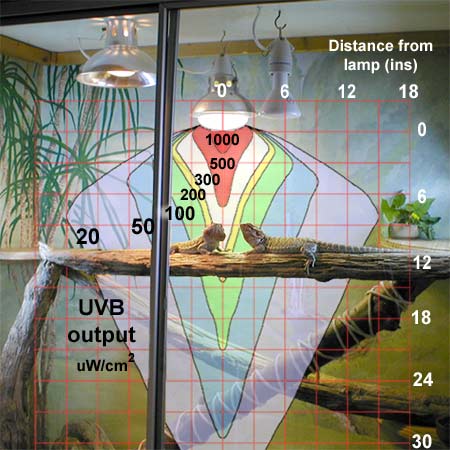 |
Figure 16 shows one of the "higher output" SB lamps (ref. BM2) in use in the large bearded dragon vivarium for which it was supplied. In this set-up, the upper basking branch is not directly under the lamp, but close to the front of the vivarium. Since the beam produces a three-dimensional "cone" of UVB radiation, this puts the centre of the branch in the area receiving between 50 - 300 uW/cm². The lower branch, directly under the lamp, also receives good UVB coverage.
 |
Figure 17 (left) is the much larger spread chart for the Zoo Mega-Ray lamp. This produces a very long teardrop shaped beam. Three feet below the lamp, the footprint is about 28" across with a gradient from 20uW/cm² to around 250 uW/cm² at the centre. (This is the manufacturer's recommended minimum basking distance.) Further away from the lamp, the beam widens slightly. Six feet from the lamp, the beam produces a footprint approximately 30" across, with a UVB gradient from 20uW/cm² up to 70 uW/cm² at its centre. Figure 18 (below) shows the UVB which a ReptileUV Zoo Mega-Ray lamp provides in a vivarium in which the lamp is fitted three feet above the basking spot of a young Ctenosaura similis(in private ownership).
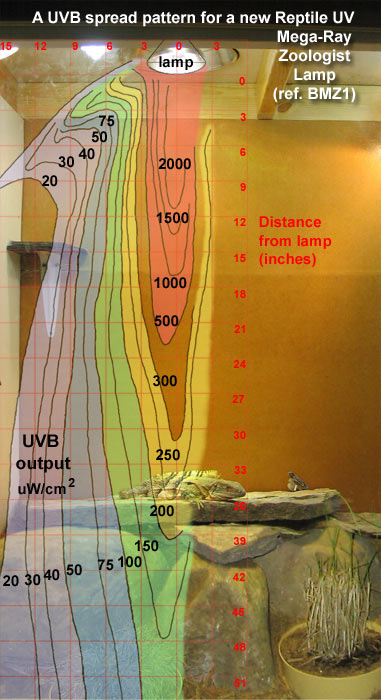
(b) UV Index Spread Charts. The high UVB output of these mercury vapour lamps makes it feasible to construct a spread chart using the Solarmeter 6.5 UVI meter, which is selectively responsive to the wavelengths which enable vitamin D3 synthesis in the skin. This would appear to be the closest one can get, with the equipment we have available, to visualising the ability of a mercury vapour lamp to facilitate vitamin D3 synthesis. The UV Index Spread Chart for one of the EB "standard output" lamps (output 202 uW/cm² at 12") is shown in Figure 19 (below). The lamp is producing a footprint,
at 12" distance, of UV equivalent to spring or summer sunlight (UVI
between 3 - 8) about six inches across.
|
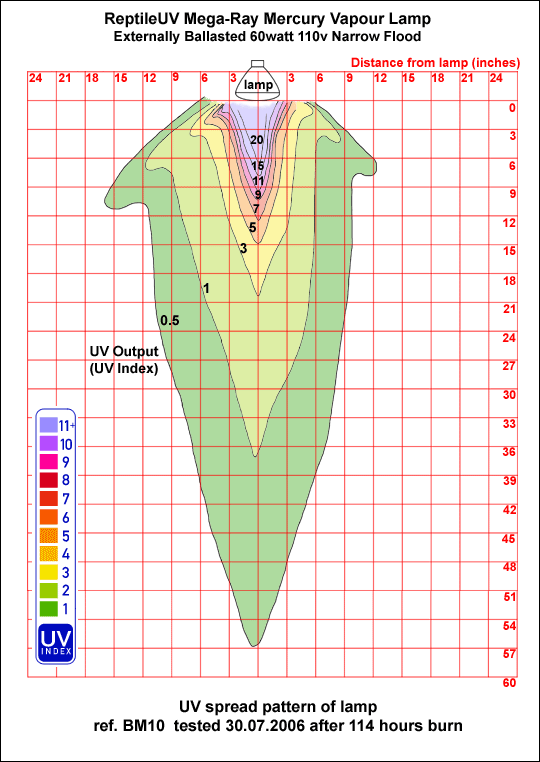
Recordings were taken with the Ocean Optics spectrometer at a standard distance of 12" from the lamp surface.
Figure 20 shows the full UV and visible spectrum of the Mega-Ray Zoo Lamp, in comparison with that of the sun and of a halogen lamp, which, like other types of incandescent bulb, is frequently used as a basking lamp. (The actual intensities of these three are obviously very different; this graph shows only relative spectral power distribution.)
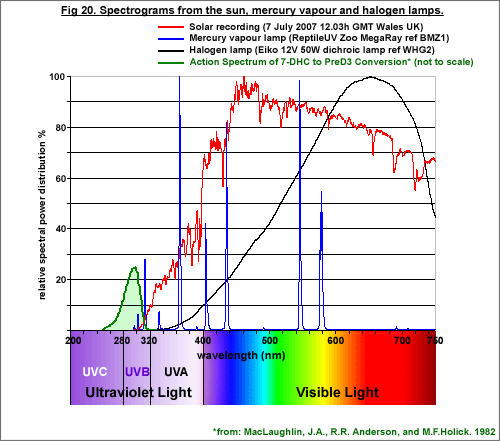 The
sun produces a continuous spectrum from UVB (around 290nm) to infra-red,
with a peak at about 460nm.
The
sun produces a continuous spectrum from UVB (around 290nm) to infra-red,
with a peak at about 460nm.
The halogen lamp spectrum is a bell curve typical of "black body radiation"
but it is lacking in ultraviolet and blue, having much more of its output in the red
wavelengths, peaking at around 650nm.
The mercury vapour lamp produces only spikes of radiation at the specific
wavelengths typical of a high-pressure mercury vapour arc. Because there are
large spikes only in the UVA, purple, blue, green and yellow wavelengths, the
light from these lamps appears, to the human eye, blue-green and lacking in
"warmth". (Hence the warmer tones of the halogen lamp complement it well.) The
only wavelengths involved directly in vitamin D3 synthesis are those in the
UVB and very low UVA range (280 - 335nm).
The action spectrum for the conversion
of the cholesterol 7-DHC to pre-vitamin D3, as described by MacLaughlin et al
(12) is shown as an overlay. The wavelengths involved in this conversion are those below 315nm. Wavelengths
between 280nm and 335nm are also involved in several photochemical control mechanisms
preventing excessive vitamin D3 production. The amount of light produced at
these wavelengths is very small indeed. However, in the UVB range, mercury vapour
lamps produce small spikes of radiation at 296nm and 302nm and a larger spike
at 313nm. The former two are in very good positions for promoting D3 synthesis.
Figure 21 shows the full spectrum of one of the EB "standard output" lamps. This is a very characteristic spectrum from a mercury vapour arc tube. Recordings from SB lamps (not illustrated) also show a small extra component - visible light - from the incandescent filament but this does not alter the ultraviolet spectrum of the lamp in any way.
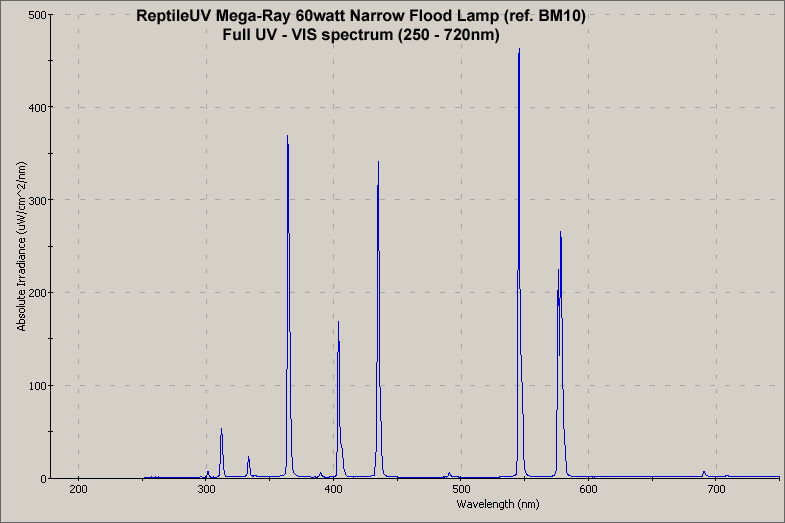
Figure 22 shows the spectra in just the UVB wavelengths (280 - 320nm) for a selection of four of the Mega-Ray lamps.
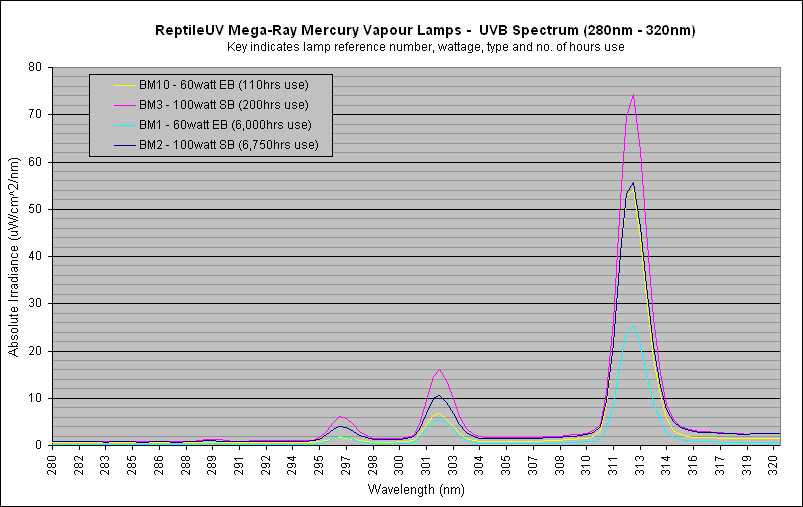
All spectra demonstrate small spikes of radiation at 296nm and 302nm and a larger spike at 313nm. When the spectral power distribution is considered in conjunction with the action spectrum for the conversion of the cholesterol 7-DHC to pre-vitamin D3 (as shown for one of the lamps, in Figure 23, below) it is evident that these lamps should be effective in producing vitamin D3 synthesis in the skin.
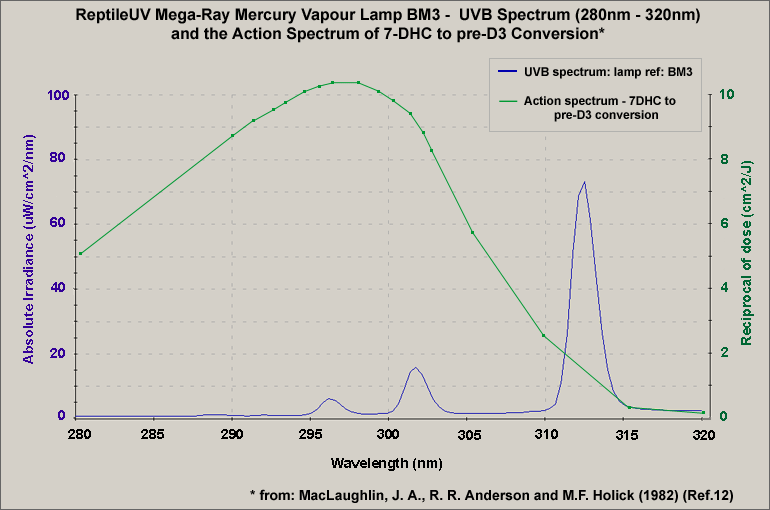
It is also interesting to consider the readings taken with the Solarmeter broadband meters, in view of the spectra. These are summarised in Figure 24.
| Fig. 24. Solarmeter recordings at 12" from lamp face | ||
| Lamp ref. no. and details: | Solarmeter 6.5 (UV Index) | Solarmeter 6.2 (total UVB - uW/cm²) |
| BM1 (60w EB - 6,000hrs use) | 5.9 | 98 |
| BM2 (100w SB - 6,250hrs use) | 12.0 | 221 |
| BM3 (100w SB - 200hrs use) | 18.1 | 346 |
| BM10 (60w EB - 110hrs use) | 7.4 | 202 |
The ability of the Solarmeter 6.5, in particular, to distinguish easily between lamps BM2 and BM10 is of note. Their irradiance at 313nm is very similar; it is only at the lower wavelengths - those associated with D3 synthesis - that lamp BM2 has a significantly higher output.
The power consumption of each lamp was recorded using a Prodigit Power Monitor model 2000M-UK (www.prodigit.com.) Readings were taken after each lamp had been alight for 30 minutes.
The 220v SB lamps were connected directly to the normal UK line voltage through the power monitor. The EB lamps, connected to their matching ballast boxes, were supplied by a 220v -110v step-down transformer which was connected to the line voltage through the power monitor. Hence, in the case of the EB lamps the monitor recorded the power consumption of bulb, ballast and transformer.
The results are shown in Figure 25.
| Fig. 25. Power Consumption of ReptileUV Mega-Ray Lamps | |||
| Lamp details: | watts | VA | amps |
| EB Mega-Ray 60w (BM1) | 71 | 107 | 0.43 |
| EB Mega-Ray 60w (BM5) | 62 | 91 | 0.38 |
| EB Mega-Ray 60w (BM6) | 65 | 89 | 0.38 |
| EB Mega-Ray 60w (BM10) | 63 | 89 | 0.38 |
| EB Mega-Ray Zoo Lamp 60w (BMZ1) | 60 | 88 | 0.67 |
| SB Mega-Ray 100w (BM2) | 113 | 119 | 0.51 |
| SB Mega-Ray 100w (BM3) | 122 | 126 | 0.53 |
| SB "Mega-Ray Low" 100w (BM9) | 118 | 122 | 0.51 |
Summary of Results/ Conclusion
These samples from the ReptileUV Mega-Ray range of narrow flood lamps all produced wide, powerful beams of UVB light. The output of individual lamps varied considerably, but all produced levels of UVB, at the manufacturer's recommended minimum basking distance (MRMBD), similar to levels seen in natural sunlight, except for the Mega-Ray Zoo Lamp (which produced slightly more).
Figure 26 summarises the output of each lamp on test, at the MRMBD. (Gaps in the table indicate that the lamp in question was not available at the time when the recording was made.)
| Fig. 26. The output of each lamp at the manufacturer's recommended minimum basking distance (MRMBD) | ||||||
| Type of lamp | Distance at which recording made (MRMBD) (inches) | Lamp ref. no. | No. of hours use when this set of recordings made |
UVB (uW/cm²) |
UV Index |
Visible light (lux) |
| Mega-Ray "Low" | 12 | BM9 | 105 | 71 | 2.5 | 9,400 |
| MegaRay "standard output" | 12 | BM4 | 105 | 157 | ||
| 12 | BM5 | 105 | 122 | 5.0 | 10,240 | |
| 12 | BM10 | 105 | 202 | 7.4 | 19,150 | |
| 12 | HM1 | 500 | 180 | |||
| 12 | HM2 | 500 | 160 | |||
| Mega-Ray "high output" | 18 | BM1 | 1500 | 184 | 11.5 | 8,400 |
| 18 | BM2 | 3000 | 118 | 6.0 | 6,400 | |
| 18 | BM3 | 180 | 153 | 8.7 | 7,700 | |
| 18 | BM6 | 110 | 146 | 8.3 | 7,250 | |
| Mega-Ray Zoo Lamp | 36 | BMZ1 | 90 | 259 | 16.4 | 8,470 |
Spread charts indicate that these lamps produce a broad beam with a footprint, at the MRMBD, of between 14 to 31 inches wide with a UVB gradient from 20 uW/cm².
Spectroscopic analysis confirmed the UV Index measurements; all lamps produce significant quantities of UVB in the range of wavelengths which enable the synthesis of vitamin D3 in the skin (between 280 - 315nm).
The initial ("burn-in") decay is extremely low for a UVB-emitting lamp. Recordings were taken from seven lamps giving an average decay of only 3.5% (range 0.6% to 5.7%) after 90 - 105 hours burn. Only two lamps have been on test for a full year; results are less conclusive with one lamp decaying by 66% but the other by only 15%, which is a remarkably low rate of decay.
Author's note
Along with colleagues Rob Lane, Rachel Hitch and Andy Beveridge, I am presently working on a project testing the UVB output of lighting equipment for reptile vivaria, using hand-held UVB radiometers and a laboratory spectrometer. We are not professionals; we are merely interested amateur herpetologists. We have research grade equipment, but our tests are not in laboratory-controlled conditions. We do believe our equipment and methods are producing reliable and repeatable results which have scientific validity, but we would encourage others to confirm our findings. Any comments we make about the suitability of the lamps for any particular use are our personal opinions only. All our test results are (or will be) published on our website, UV Guide UK. (www.uvguide.co.uk)
Individual lamps will vary in their UVB output, depending upon their original specifications and upon their age, the condition of the ballast, the quality of the electrical supply and doubtless, other factors. I hope this report gives a useful insight into the sort of output I think one can expect from these products. However, I have only thoroughly tested nine lamps. To be certain that these were typical of their kind would require a much larger sample to be tested. Because there will inevitably be differences between individual lamps, the charts for the lamps tested in this report should not be relied upon as an accurate guide to the exact output of all lamps of this type.
I would like to thank Robert MacCargar of ReptileUV for the generous donation of all the ReptileUV lamps and lamp kits described in this report.
1. Baines, F.M. 2006. Solar recordings compiled by members of the UVB_Meter_Owners internet group. (available online: accessed 31st March 2006) http://groups.yahoo.com/group/UVB_Meter_Owners/files/SolarUVB
2. Goetz, M. 2005. UV-B readings - Grand Cayman. Unpublished data
3. Alberts, A. 1993. Ultraviolet Light and Lizards: More than meets the Eye. The Vivarium 5(4): 24-25.
4. Adkins, E., T. Driggers, G.Ferguson, W.Gehrmann, Z.Gyimesi, E. May, M. Ogle and T. Owens. 2003. Ultraviolet Light and Reptiles, Amphibians. Journal of Herpetological Medicine and Surgery 13(4): 27 - 37.
5. Donoghue, S. 2006. Nutrition. In: Reptile Medicine and Surgery (2nd Edition). D. R. Mader, editor. WB Saunders, NY.287
6. Fyfe, G. 2004. Ultraviolet Lighting for Captive Reptiles – a review (testing the conventional wisdom and advertising) Proceedings of the 2004 C.A.R.A. (Care of Australian Reptiles and Amphibians) Conference 17 – 26
7. Coote, J. 1997. Ultra-violet Lights or Vitamin D3 for your Reptiles? Herptile 22 (2): 76 – 80
8. Baines, F., R. Hitch and R. Lane. 2005. Looking at UVB in a new light (Part 3) Herptile, Journal of the International Herpetological Society 30 (4) 148 – 172
9. Gehrmann, W.H. 2006. Artificial Lighting. In: Reptile Medicine and Surgery (2nd Edition). D. R. Mader, editor. WB Saunders, NY. 1083
10. Aucone B.M., W.H. Gehrmann, G.W. Ferguson, T.C. Chen, and M.F. Holick. 2003. Comparison of two artificial ultraviolet light sources used for Chuckwalla, Sauromalus obesus, husbandry. Journal of Herpetological Medicine and Surgery 13(2):14-17.
11. Carman, E.N., G.W. Ferguson, W.H. Gehrmann, T.C. Chen and M. F. Holick. 2000. Photobiosynthetic Opportunity and Ability for UVB Generated vitamin D synthesis in free-living house geckos (Hemidactylus turcicus) and Texas Spiny Lizards (Sceloporus olivaceous). Copeia 2000 (1): 245-250.
12. MacLaughlin,
J.A., R.R. Anderson, and M.F.Holick. 1982. Spectral character of sunlight
modulates photosynthesis of previtamin D3 and its photoisomers in human skin.
Science 216(4549):1001-1003.